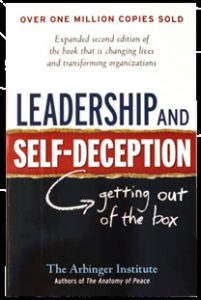Leadership and Self-Deception: Getting Out of the Box
Reviewed by Catherine Brear
 The Arbinger Institute’s Leadership and Self-Deception: Getting Out of the Box is engaging and easy to read, with numerous applications to both professional and personal settings. Through the instructive story of Tom Callum, we become aware of what self-deception is, how often we self-deceive, and how we may not be aware of the problem. As leaders, self-deception can undermine our goals, relationships, and organizational results.
The Arbinger Institute’s Leadership and Self-Deception: Getting Out of the Box is engaging and easy to read, with numerous applications to both professional and personal settings. Through the instructive story of Tom Callum, we become aware of what self-deception is, how often we self-deceive, and how we may not be aware of the problem. As leaders, self-deception can undermine our goals, relationships, and organizational results.
Presenting the argument that many organizational and personal problems stem from self-deception, the story follows the life of Tom Callum, a senior manager at a large organization. Facing challenges in a new job, Tom struggles to maintain his marriage and raise his 16 year-old son.
The story begins with the simple premise that when we get a feeling, we have a choice: we can honor that feeling or we can betray it. We honor our feelings when we act on them, and we betray our feelings – that is to say, we self-deceive – when we fail to act on them. Furthermore, when we betray our feelings, our focus turns to justifying our lack of action and that puts us “in the box.” Being “in the box” means that we not only distort the way we see ourselves, but also how we see others; people become objects to serve our needs, and we rationalize our self-betrayal, our self-deception.
Tom’s journey urges us all to examine our own behavior as leaders, friends, family members, team members, and colleagues. We are called to focus less on what we do, and more on who we are and our “way of being” with others. When we are “out of the box” and cease resisting our feelings, we see others as people with their own hopes, needs, and fears. Have you been “out of the box” lately? With whom? What can you do to help others?



